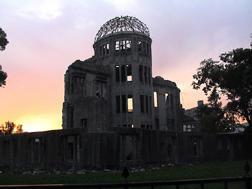How to Make Your Own Atomic Bomb

Suppose you’re a terrorist — not a run-of-the-mill suicide-bomber , but a smart, nasty son of a gun, intent on doing as much damage as possible. Your best approach is to develop a little atomic bomb about the size of the one used on Hiroshima. You don’t need any particular expertise, since you don’t have to meet the quality standards that a military commander would demand. Could it be done? Yes, in a recent paper (“The Risk of Nuclear Terrorism and How to Decrease It”) the Italian physicist and prominent Pugwashite Francesco Calogero has described it as an easy project.
You wouldn’t have to make it transportable; you could build it in a basement someplace and set it off right there with a timer. Everything that you need is available freely on the open market except one key ingredient: a sufficient quantity of uncontaminated Highly Enriched Uranium (HEU ) containing at least 90% U-235. You don’t even need a neutron source to initiate the chain reaction, though having one would improve the yield of your bomb, and they aren’t hard to build. All you need is to assemble a supercritical mass of HEU very fast — within about a millisecond. A gun can achieve that.
How much HEU would you need? The Hiroshima bomb was exploded by the fission of about one kilogram of HEU. Certainly 100 kilograms would be more than enough for your own primitive bomb. Once you get it, smuggling it will be easy. It will have a low radioactive signature and will occupy less than ten liters of space.
But supposedly that’s the only real hitch: obtaining a kilogram of the stuff, since no country is going to give it away or sell it to you. And as a mere would-be terrorist, you are unable to make it yourself. Indeed, only a few states can produce it. Calogero believes that the only reason why such an explosion hasn’t happened yet is that terrorists haven’t been able to get a sufficient quantity of weapon-grade uncontaminated HEU.
Where will you get it? The most promising source is Russia , where there are more than one million kilograms of it, dispersed over more than 100 sites. Russia has declared half a million kilograms of it as surplus. And possibly one percent or more of it is unaccounted for — offering you quite an exceptional opportunity.
Calogero, however, fervently wishes to prevent your construction of a primitive nuclear bomb. He recommends one particular means of guaranteeing security: that the HEU be eliminated as quickly as possible. This actually can be done easily and cheaply by blending it down into Low Enriched Uranium (LEU) containing about 3-5% U-235. LEU is the standard fuel for commercial nuclear reactors , and it cannot easily be transformed back into HEU. The United States and Russia once agreed to down-blend 500 tons of Russian HEU and sell it to American utilities for $10 billion. However, this has not happened promptly, but is being done over a period of 20 years. So far, over 230 metric tons of Russian HEU has been downblended, and the work is proceeding at the rate of eliminating 30 tons per year. More could be done, faster, as Calogero strongly suggests. At Kananaskis , the Group of Eight agreed in principle to spend $10 billion US by the US itself, plus another $10 billion by the other countries over the next ten years to alleviate the risk of the use of HEU by terrorists.
More attention has actually been focused on eliminating Plutonium than HEU, for Plutonium is the only other material suitable for the construction of a nuclear bomb. However, Calogero regards this as a misplaced concern, for there is vastly more HEU around than Plutonium, and it is more difficult to build a bomb with Plutonium.
Clearly, Calogero’s rationale for this program is based on his concern about preventing terrorists from building bombs. His paper does not mention the contrary argument, but it should be taken into account. Many people concerned with HEU do not favor its downblending and use in commercial nuclear reactors. However it is handled, nuclear power itself is inherently dangerous. Radiation pollutes the environment in the vicinity of nuclear reactors and causes much higher brain cancer rates than elsewhere. Ultimately, nuclear power will be superseded by other types of energy. The question remains, though: How can HEU be kept safely without blending it down into LEU? I don’t know the answer.



1 Comments:
I have some great ideas :) Nevermind. Next time.
Post a Comment
<< Home